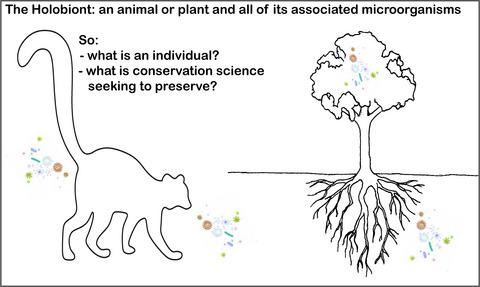当前位置:
X-MOL 学术
›
Funct. Ecol.
›
论文详情
Our official English website, www.x-mol.net, welcomes your
feedback! (Note: you will need to create a separate account there.)
Conserving the holobiont
Functional Ecology ( IF 4.6 ) Pub Date : 2020-01-02 , DOI: 10.1111/1365-2435.13504 Alexandra J. R. Carthey 1 , Daniel T. Blumstein 2 , Rachael V. Gallagher 1 , Sasha G. Tetu 3 , Michael R. Gillings 1
中文翻译:

保全全息
更新日期:2020-01-02
Functional Ecology ( IF 4.6 ) Pub Date : 2020-01-02 , DOI: 10.1111/1365-2435.13504 Alexandra J. R. Carthey 1 , Daniel T. Blumstein 2 , Rachael V. Gallagher 1 , Sasha G. Tetu 3 , Michael R. Gillings 1
Affiliation

|
- Organismal biology has undergone a dramatic paradigm shift in the last decade. The realization that host cells and genes are outnumbered by symbiotic microbial cells and their genes has forced us to rethink our focus on ‘individuals’. It is also becoming increasingly clear that the ecology and biology of animals and plants are intimately connected with their microbial partners. In the context of conserving functioning species, such revelatory insights beg the question—what exactly should we be trying to conserve?
- Here, we review how an understanding of host–microbe interactions can benefit conservation biology. We propose a way forward for conservation biologists, to gather evidence of the potential effects of changes to plant and animal microbiomes, and to incorporate the holobiont concept into applied conservation practice.
- In humans, microbes influence physiology, health, behaviour and psychology. In animals and plants, microbes similarly influence critically important components of health, communication and (in animals) behaviour. Together, the animal or plant and all of its associated micro‐organisms are termed the holobiont.
- At the same time, humans are now the strongest evolutionary force on the planet, causing global change at unprecedented scale. We know that microbial diversity in humans has been compromised in urban societies, with a growing list of consequences for health and function. While we still have limited evidence for similar effects in plants and animals, anthropogenic factors that affect diversity are also likely to affect animal and plant microbiomes, with similar associated effects on host function and health.
- Microbiome research is still in its relative infancy, particularly in its application to plants and animals, yet the tools are becoming more widely available and affordable. Forward‐looking conservation biologists could harness such tools and apply them to the study of plant and animal microbiomes with the goal of understanding which microbiota might be required to ensure future viability of conserved host populations.
- For now, the precautionary principle applies. We suggest that, to meaningfully and effectively conserve a species, we must also consider how to conserve the bacteria, viruses, fungi and other symbionts intimately associated with that macro‐organism.
中文翻译:

保全全息
- 在过去的十年中,生物生物学发生了巨大的范式转变。认识到宿主细胞和基因被共生微生物细胞及其基因数量所超越,迫使我们重新考虑对“个体”的关注。越来越明显的是,动植物的生态和生物学与其微生物伴侣之间有着密切的联系。在保护功能性物种的背景下,这种启发性的见解引出了一个问题-我们到底应该努力保护什么?
- 在这里,我们回顾了对宿主-微生物相互作用的理解如何使保护生物学受益。我们为保护生物学家提出了一条前进的道路,收集有关动植物微生物群变化潜在影响的证据,并将全生命周期概念纳入应用的保护实践中。
- 在人类中,微生物会影响生理,健康,行为和心理。在动植物中,微生物同样会影响健康,交流和(在动物中)行为的至关重要的组成部分。动物或植物及其所有相关微生物一起被称为全生命动物。
- 同时,人类现在是地球上最强大的进化力量,以前所未有的规模引发了全球变化。我们知道,人类微生物多样性在城市社会已经受到损害,对健康和功能的影响越来越多。尽管我们对植物和动物具有类似作用的证据仍然有限,但影响多样性的人为因素也可能会影响动物和植物的微生物组,并对宿主功能和健康产生相似的相关影响。
- 微生物组研究仍处于起步阶段,特别是在植物和动物中的应用,然而这些工具正变得越来越普及和负担得起。具有前瞻性的保护生物学家可以利用这些工具,并将其应用于植物和动物微生物组的研究,以期了解可能需要哪些微生物来确保受保护宿主种群的未来生存能力。
- 目前,预防原则适用。我们建议,为了有意义和有效地保护一个物种,我们还必须考虑如何保护与该大生物密切相关的细菌,病毒,真菌和其他共生体。











































 京公网安备 11010802027423号
京公网安备 11010802027423号